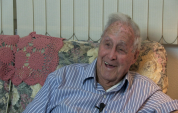4:29 | After a bombing mission, there was always brandy and a debriefing. Hugo Riva reveals that every B-17 at that point in the war had cameras aboard. That put a stop to gunners inflating their numbers. When new fighters were brought in as escorts, the bomber crews could breathe a little bit easier.
Keywords : Hugo Riva flight engineer Boeing B-17 Flying Fortress brandy debriefing photography (photo) camera North American P-51 Mustang fighter escort flak

Hugo Riva was facing the draft like everyone and he didn't like the idea of walking very much. Luckily, he was accepted in the Army Air Corps and began the long training regimen.
B-17 flight engineer Hugo Riva recalls his buddies on the crew and the camaraderie they shared. He also praises the airplane they flew, the Boeing B-17. It could withstand unbelievable damage and still return from a mission.
The people in the English town near the air base were very friendly. Hugo Riva recalls how they provided the flight crews with real eggs, a nice luxury. He was the flight engineer on a B-17, a sturdy and reliable aircraft which brought him back safely from every mission.
It was a big stink if you accidentally popped your chute on the ground during a pre-flight inspection. Hugo Riva recalls one man who wanted to make sure he didn't have that happen to him again.
The bombing missions could be long and monotonous. Once you got to the target, though, it could be deadly. They flew at high altitude and Hugo Riva describes the measures that had to be taken against the cold.
Hugo Riva did write home to his family and his girlfriend but, like most of the fellows, he would much rather get letters than write letters. When he got home after the war he went into the restaurant business and was quite successful.